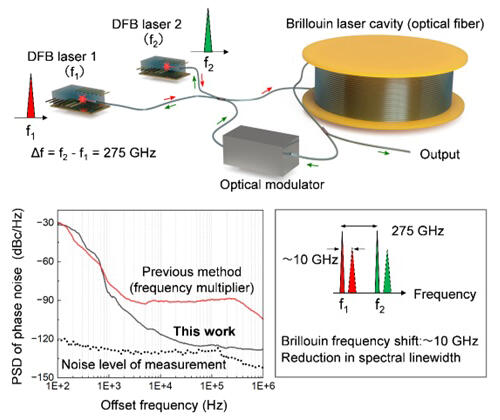A research group made up of Professor Tadao Nagatsuma, Research Associate Professor Keisuke Maekawa, and Graduate Students Tomoya Nakashita and Toki Yoshioka from the Graduate School of Engineering Science at Osaka University, along with IMRA AMERICA, INC. aimed to use ultra-low noise sub-THz signal generators based on optical technology in both the transmitter and receiver of a 300 GHz wireless communication system. They achieved a transmission speed of 240 Gbit/s, making it the world's highest for a single-channel wireless communication system. This report was pre-released online in IEICE Electronics Express published by the Institute of Electronics, Information and Communication Engineers (IEICE).

Provided by Osaka University
Research and development beyond 5G/6G is gaining momentum around the world with the goal of commercialization by the 2030s. As key performance indicators, speed and capacity are 10 to 100 times higher than the values for 5G, with the speed ranging from 100 Gbit/s to 1 Tbit/s. One effective means of achieving this is expected to be the use of radio waves in the 100 GHz to 300 GHz (sub-terahertz) range, where a wide frequency bandwidth is available. For higher speeds, it is effective to use a multi-level modulation scheme with high-frequency utilization efficiency. Amplitude noise and phase noise in signal generators have posed significant challenges for multi-level modulation in the sub-terahertz band.
In the generation, control, and detection of sub-terahertz signals, the research group used optical signal generators known as Brillouin light sources in addition to optical communication wavelength (1.55 µm) band lasers, optical modulators, and photodiodes. These components, which have been developed in optical communication technology, were used in the transmission and reception systems. The Brillouin light source injects light waves of two different wavelengths, generated by a semiconductor laser, into a highly stable optical fiber resonator (resonator length of 75 m) and locks them to the resonant frequency. Additionally, the line width of the optical signal propagating through the optical fiber is narrowed by the stimulated Brillouin scattering phenomenon, which contributes to addressing the frequency fluctuations of the sub-terahertz wave for enhanced stability. On the transmitting side, the light of two different wavelengths generated from the Brillouin light source is split into two optical paths.
Light of one wavelength is used to generate an optical signal modulated with 16 to 256 QAM (quadrature amplitude modulation) by employing a multilevel optical modulator that is used in digital coherent optical communications. Light of the other wavelength is not modulated and is combined with the digitally modulated light using an optical multiplexer. When this combined light is converted into an electrical signal using a photodiode, it can be converted into a radio wave whose carrier signal is a frequency corresponding to the wavelength difference between the two waves.
In the experiment, the RF (radio frequency) carrier frequency was set to 275 GHz by setting the wavelength difference to approximately 2.2 nm. The RF signal received by the antenna was converted to an intermediate frequency (IF) signal with a frequency ranging from 10 GHz to 30 GHz using a subharmonic mixer. For example, to obtain an IF frequency of 20 GHz, a local oscillator (LO) signal with a frequency of 127.5 GHz is applied to the subharmonic mixer. Traditionally, this LO signal undergoes a process of converting a microwave signal of 10 GHz to 30 GHz to a frequency 10 to 30 times higher using a frequency multiplier, similar to the RF signal on the transmitter side. As a result, the generated RF/LO signal has a problem: large amplitude noise and phase noise. By using a Brillouin light source to generate both the RF/LO signals, it is possible to reduce amplitude noise and phase noise to less than 1/100th of the conventional levels.
In the experiment, a very low bit error rate was achieved at a high communication speed of 252 Gbit/s. The research group is currently working on R&D to increase the transmission power by improving photodiodes, increasing the sensitivity of the receiving elements, and increasing the antenna gain to achieve even higher speeds and a communication distance of 200 m or longer.
Nagatsuma said, "Research on wireless communications using sub-terahertz waves continues to face fierce competition, especially from Japan, the United States, Europe, and China. This achievement is part of a collective effort by Osaka University, IMRA AMERICA, INC., the University of Tokyo, and Kyushu University under the auspices of the NICT (National Institute of Information and Communications Technology) Beyond 5G R&D Promotion Project to demonstrate Japan's technological capabilities. While the focus this time was mainly on reporting the world's highest communication speed achieved in Japan, there are other world-class results, which we will continue to announce."
Journal Information
Publication: IEICE Electronics Express
Title: Single-channel 240-Gbit/s sub-THz wireless communications using ultra-low phase noise receiver
DOI: 10.1587/elex.20.20230584
This article has been translated by JST with permission from The Science News Ltd. (https://sci-news.co.jp/). Unauthorized reproduction of the article and photographs is prohibited.




